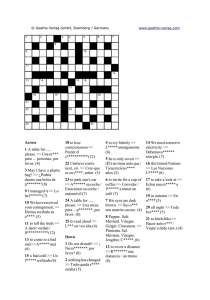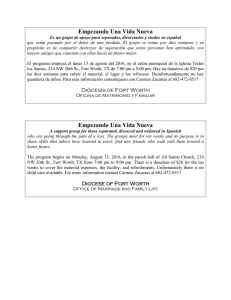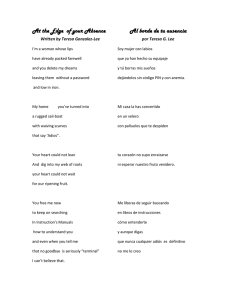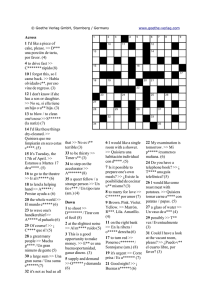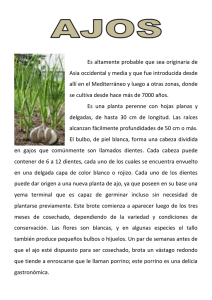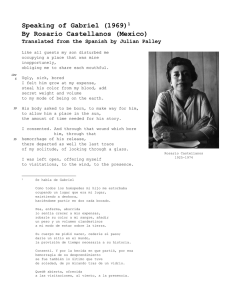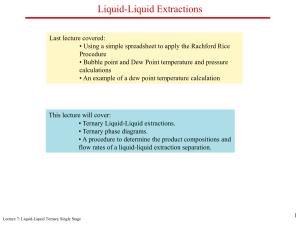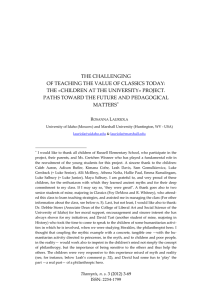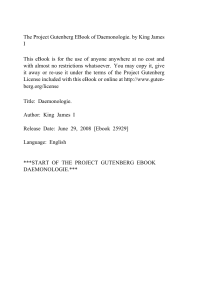Return to the classics
Anuncio
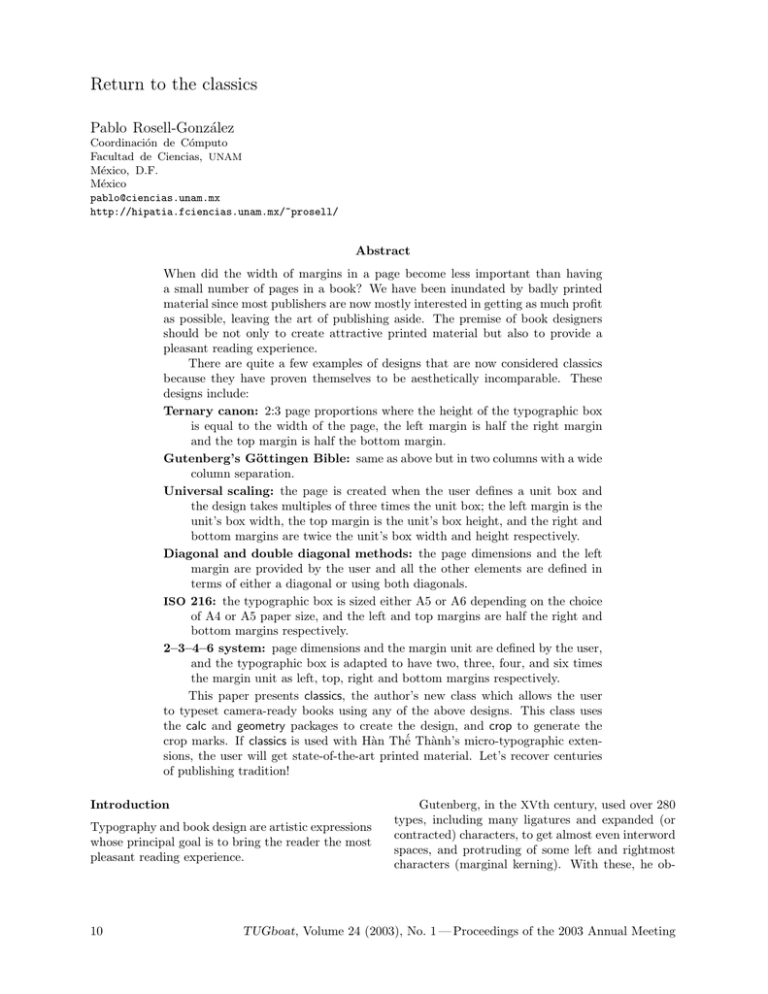
Return to the classics Pablo Rosell-González Coordinación de Cómputo Facultad de Ciencias, UNAM México, D.F. México [email protected] http://hipatia.fciencias.unam.mx/~prosell/ Abstract When did the width of margins in a page become less important than having a small number of pages in a book? We have been inundated by badly printed material since most publishers are now mostly interested in getting as much profit as possible, leaving the art of publishing aside. The premise of book designers should be not only to create attractive printed material but also to provide a pleasant reading experience. There are quite a few examples of designs that are now considered classics because they have proven themselves to be aesthetically incomparable. These designs include: Ternary canon: 2:3 page proportions where the height of the typographic box is equal to the width of the page, the left margin is half the right margin and the top margin is half the bottom margin. Gutenberg’s Göttingen Bible: same as above but in two columns with a wide column separation. Universal scaling: the page is created when the user defines a unit box and the design takes multiples of three times the unit box; the left margin is the unit’s box width, the top margin is the unit’s box height, and the right and bottom margins are twice the unit’s box width and height respectively. Diagonal and double diagonal methods: the page dimensions and the left margin are provided by the user and all the other elements are defined in terms of either a diagonal or using both diagonals. ISO 216: the typographic box is sized either A5 or A6 depending on the choice of A4 or A5 paper size, and the left and top margins are half the right and bottom margins respectively. 2–3–4–6 system: page dimensions and the margin unit are defined by the user, and the typographic box is adapted to have two, three, four, and six times the margin unit as left, top, right and bottom margins respectively. This paper presents classics, the author’s new class which allows the user to typeset camera-ready books using any of the above designs. This class uses the calc and geometry packages to create the design, and crop to generate the ´ Thành’s micro-typographic extencrop marks. If classics is used with Hàn Thê sions, the user will get state-of-the-art printed material. Let’s recover centuries of publishing tradition! Introduction Typography and book design are artistic expressions whose principal goal is to bring the reader the most pleasant reading experience. 10 Gutenberg, in the XVth century, used over 280 types, including many ligatures and expanded (or contracted) characters, to get almost even interword spaces, and protruding of some left and rightmost characters (marginal kerning). With these, he ob- TUGboat, Volume 24 (2003), No. 1 — Proceedings of the 2003 Annual Meeting Return to the classics tained perfectly visual “gray” boxes when printing his Bible. Most of these aspects are already achieved by using (LA)TEX, and the micro-typographic extensions ´ Thành for pdf(LA)TEX, explained made by Hàn Thê in [7], complete the picture. This paper is divided in two sections: the first contains a brief geometric description of some page layouts that have proven to be aesthetic and functional. Some variations obtained from them are included. The second explains the usage of classics, a class that allows the user to typeset books using those page layouts. Some instances of the usage of classics with protruding characters generated with pdfLATEX are included. A First approach to the classics Let ABCD be a page with arbitrary proportions. Consider the following construction for the type area (figure 1) which guarantees rules 1, 3 and 4. Construct diagonals AC and BM , where M is the midpoint of AD, and O the point of intersection. Take any point P between A and O. From P draw the parallel to AB which intersects BM in Q. From Q trace the parallel to BC which intersects AC in R. To obtain S, draw parallels from R and P to CD and AD respectively. Then the rectangle P QRS will have the same proportions as ABCD. Moreover, O divides in the same ratio both P R and AC, i.e., P R/P O = AC/AO = 1/3. Of course we want to leave wide enough margins on our page, so that the area of the typographic box covers no more than, say, 50%. But if we also want to follow rule 2 we must restrict√the proportions of our page to no less than 1 : 2. Table 1 shows some page ratios with the percentage of area their typographic box occupies if its height equals the paper’s width (i.e., following rule 2). 2–3–4–6 approach Take a unit u as half the inner margin of any page. If we take 2u, 3u, 4u, and 6u dimensions for the inner, top, outer, and bottom margins respectively we will get a fairly good typographic box — this depends, of course, on the width Q P O M S Classic page layouts Traditional published works present carefully studied margin proportions obeying (some of) the following four rules: 1. the diagonal of the typographic box coincides with the diagonal of the page; 2. the height of the typographic box equals the page width; 3. the outer margin is twice the inner margin; 4. the bottom margin is twice the top margin. B R D C Figure 1: First approach. Page ratios Documents 1:2 2:3 2 :√3 1: 2 3:4 1:1 — Gutenberg’s Bible Ternary Canon ISO 216 Ghostscript’s archA — % of area 25% 39.5% 44.4% 50% 56% 100% Table 1: Page ratios and typographic box area. to height ratio of the page and on the value of u respect to the width of the page. In most cases (except for a 2 : 3 page), the typographic box will not present the same width to height ratio as the page, because if w and h represent the width and height of the page, then the typographic box will be w − 6u in width and h−9u in height. Suppose the page and type area have the same proportions; then w − 6u 2 w = = . h h − 9u 3 This is, nevertheless, a good method for obtaining interesting asymmetrical results. Ternary Canon Many medieval and Renaissance manuscripts and printed books present a 2 : 3 width to height page ratio whose typographic box not only follows the four rules mentioned above but also presents the 2–3–4–6 progression in the margins. TUGboat, Volume 24 (2003), No. 1 — Proceedings of the 2003 Annual Meeting 11 Pablo Rosell-González Following Van der Graaf’s method, Jan Tschichold [8] published an elegant geometrical way to obtain such a layout. Take a two-page diagram (see figure 2), draw diagonals AC and BD which intersect at M , the midpoint of EF ; draw diagonals EC and ED which intersect BD and AC at G and G′ respectively. Draw GG′ and perpendiculars through G and G′ to AB which intersect it at H and H ′ . The point of intersection P (P ′ ) of EG (EG′ ) and HG′ (H ′ G) is the upper left (right) corner of the typographic box. Complete the construction as in figure 1. A H′ E P ′ H B P Figure 3: Rosarivo’s 9 × 9 grid. At the left, the ternary canon typographic box in gray. At the right, Gutenberg’s Bible two column boxes. G G′ M D F C Figure 2: Tschichold’s geometric construction for the Ternary Canon. The circle in figure 2 simply shows that the height of the typographic box equals the width of the page. That the margins are in 2–3–4–6 progression follows from the fact that the top left corner of the box divides in 1/9 both the height and the width of the page. If we fix a unit u which is half the inner margin then the page will have width 18u and height 27u, so the inner margin is 2u wide, the top margin is 3u high. Because the height of the type area is equal to the width of the page, 18u, the bottom margin is 27u − (3u + 18u) = 6u. Moreover, as the typographic box is in the same ratio as the page its width is 12u, thus the outer margin is 18u − (2u + 12u) = 4u. On the other hand, a much different approach is given by Raúl Rosarivo [6], who discovered that creating a 9 × 9 grid on a 2 : 3 ratio page (figure 3, left), and positioning the typographic box leaving one column and one row of the grid as inner and top margins, and two columns and rows as outer and bottom margins, gives exactly the same position 12 and proportions for the typographic box to fulfill the rules and the 2–3–4–6 progression. In the ternary canon model, the typographic box will cover only 4/9 (44%) of the area of the paper. Gutenberg designed his Göttingen Bible of 42 lines using the ternary canon model, but the text is written in two columns whose separation space is exactly 2/3 the width of the grid’s cells as shown in figure 3 (right); each column has 2 2/3 cell width covering just (39.5%) of the area of the paper. Universal scaling Rosarivo extended this concept to n × n grids, where n is a multiple of 3. Once divided, the column and the row correspond to inner and top margins, and two columns and rows to outer and bottom margins. The margin dimensions are inversely proportional to the number of divisions made. Note, however, that if n is not a multiple of 3 we are still following rules 1, 3 and 4. A quite critical example is taking a square page and dividing it in a 10 × 10 grid. The resulting type area is a 7 × 7 box, filling 49% of the page (see figure 10). Nice, isn’t it? ISO 216 The ISO √ A range begins with the A0 sheet, whose ratio is 1 : 2 and has area 1 m2 . If we cut the A0 sheet along the middle √ of the long√side we obtain a sheet whose ratio is 2/2 : 1 = 1/ 2. This new sheet, A1, is proportional to the original one and has half A0’s area, 1/2 m2 . This process can be continued to obtain proportional sheets with half the area of the predecessor. Another range that belongs to the ISO 216 family √ starts with the B0 √ sheet, whose ratio is again 1 : 2 and has area 2 m2 , i.e., whose width is 1m. TUGboat, Volume 24 (2003), No. 1 — Proceedings of the 2003 Annual Meeting Return to the classics Name dimensions (mm) A0 A1 A2 A3 A4 841 × 1189 594 × 841 420 × 594 297 × 420 210 × 297 B5 176 × 250 A5 A6 area (m2 ) 1 1/2 1/4 1/8 1/16 √ 148 × 210 105 × 148 2/32 1/32 1/64 A6 Table 2: ISO 216 A range and B5 page dimensions. It happens that the B range consists of the geometric means of the A range. For example, the height of B5 is equal to the square root of the product of the heights of A4 and A5. Table 2 shows the dimensions of the A range up to 6 divisions, and B5, between A4 and A5 in italics. Figure 4 shows a sketch of the A range. A5 A4 Figure 5: A5 as the typographic box of an A4 page (light gray in white), and A6 in A5 (dark in light gray). The classics class The classics class is primarily intended to typeset books using any of the designs explained in the previous section, along with some variations of them. The user invokes classics like any other class: A2 A1 \documentclass[options]{classics} A6 A5 A8 A7 A3 A4 The description of options will be divided into the generic ones which are inherited from the book class, and the specific ones created for classics together with the commands (parameters) related to each page layout. Figure 4: Subdivisions of an A0 sheet. Generic options The following list shows the options inherited from book, which do not relate to the page design whatsoever. What is really important about this system is that it allows us two things. First, we can make a complete sheet from, say, 8 physical pages without having to make unnecessary cuts. Second, we can reduce the size of the page to its immediate successor, retaining proportions, using pstops, psnup, or some other tool; or by means of photographic media. Let An be the page; then if A(n + 1) is the typographic box which, as mentioned above, has 50% the area of the page (not far from the 44.4% of the ternary canon). If we follow the four rules (as √ shown in√figure 5) the margin progression will be 2–2 2–4– 4 2 which is approximately 2–2.828–4–5.657 which is not very far from the ternary canon’s progression. 10pt|11pt|12pt For choosing the normal type size. The default is 10pt. final|draft Shows (draft) black boxes for overfull lines or not (final). The final option is the default. oneside|twoside For printing on one or both sides of a page. The default is twoside, which produces mirrored layouts of even and odd pages. The oneside option makes even pages the same as odd numbered ones. openright|openany For the chapters to begin only on recto pages (openright) or on any pages (openany). The default is openright. onecolumn|twocolumn Specifies if the text box will be one or two columns per page. The default TUGboat, Volume 24 (2003), No. 1 — Proceedings of the 2003 Annual Meeting 13 Pablo Rosell-González is onecolumn unless the gutenberg option is chosen. (See Specific options.) titlepage|notitlepage If \maketitle is invoked, by default classics (book) will make a separate title page, and a separate abstract page, if any. openbib To format the bibliography in open style. leqno Formula numbers will be put to the left for any numbered display math environments. fleqn Aligns to the left displayed formulae. As classics is intended specifically to produce page layouts whose dimensions are not, in general, standard, book paper size options (letterpaper, legalpaper, . . . ) are not recognized. Specific options The classics class offers the following options for page layouts in contrast to page size options of book; ternary being the default. ternary This layout builds a 2 : 3 width-to-height page with type area as described in figures 2 and 3. The only parameter users can modify is \classicswidth (see Parameters) because all other parameters are absolutely determined. ✂✁☎✄✝✆✟✞✝✠☛✡☛✞✝☞✌✁✎✍✑✏✓✒✕✔✕✔✕✖☛✗✎✒☛✗✎✘✙✏✛✚☎✜ ✒✕✢✣✏✥✤✎✦✝✁✕✞✙✚✧✏✓★✩✚ Como aplicación elemental del gas ideal de fermiones consideraremos el problema de las estrellas de neutrones y las lamadas enanas blancas. Una estrella normal como nuestro sol produce energı́a principalmente por la fusión de núcleos ligeros, como el hidrógeno, a núcleos más pesados, como el helio. La presión térmica proveniente de la energı́a cinética de las partı́culas constituyentes, más la presión de radiación, se equilibran con la compresión gravitacional de las masas en atracción, y la estrella mantiene una cierta estabilidad de tamaño o radio ✪✬✫ , que es del orden de ✭✯✮✱✰✳✲✵✴✷✶ cm. Al agotarse este mecanismo de producción de energı́a por fusión, y después de pasar por una etapa de gigante roja, en que la estrella se enfrı́a y se expande enormemente, ocurre la muerte de la estrella que dependiendo de la masa de la estrella puede terminar como: Una enana blanca, compuesta principalmente por núcleos de helio-4 (o carbono-12 o hierro56) inmersos en un mar de electrones liberados; el sistema está a temperaturas entre ✰☎✲✵✸ y ✰✳✲✺✹☎✻☎✼ y densidades entre ✰☎✲✵✽ y ✰☎✲✿✾ ❀✺❁❃❂❅❄☛❁❇❆ . Una estrella de neutrones, compuesta en un 99% por los neutrones remanentes después de la conversión de los protones y electrones en i, a neutrones por el proceso de decaimiento beta inverso ❈❊❉●❋✿❍❏■▲❑✱❉◆▼ forzado por la compresión resultante de la gravedad. Si la masa es suficientemente alta, la estrella termina como un agujero negro, en que la contracción gravitacional reduce el tamaño de la estrella a un lı́mite tal que su velocidad de escape es igual a la velocidad de la luz, de modo que ni los fotones pueden escapar. Este radio, llamado radio de Schwartzschild ✪P❖ , definido por ◗✧❘◆❙ ❂ ✪P❖◆❚❯❙❲❱❨❳ ❂❅❩ , o ❩ ❂ bien ✪✬❖❬❚ ◗✧❘ ❱☛❳ , donde ◗ es la constante de gravitación, ❘ y ❙ son las masas de la estrella y de una partı́cula de prueba, respectivamente. El tipo 1 de cadáver de la estrella normal con que empezamos ocurre generalmente cuando la masa de ésta es del orden de magnitud de una masa solar ❘❭✫ , el tipo 2 cuando es diez veces ❘❭✫ y el tipo 3 cuando es 100 o más veces ❘ ✫ ; al grado que ningún mecanismo de presión es capaz de contrarrestar la contracción gravitacional. La figura 47 compara los tamaños relativos de una gigante roja, nuestro sol, una enana blanca, una estrella de neutrones y un agujero negro. Los radios de Schwartzschild ✪ ❖ para cuerpos con la masa de la Tierra o del Sol serı́an, respectivamente, un centı́metro o tres kilómetros. Una enana blanca tı́pica con una masa solar ✫ ❘ tiene un radio ✪❫❪▲✰☎✲ Km, un poco mayor que el radio correspondiente de Schwartzschild ✪✬❖✩❚❵❴ Km. \documentclass[gutenberg,utopia,frame]{classics} Figure 7: Page layout for gutenberg option. “ternary” — 2003/2/9 — 1:30 — page 1 — #1 Como aplicación elemental del gas ideal de fermiones consideraremos el problema de las estrellas de neutrones y las lamadas enanas blancas. Una estrella normal como nuestro sol produce energı́a principalmente por la fusión de núcleos ligeros, como el hidrógeno, a núcleos más pesados, como el helio. La presión térmica proveniente de la energı́a cinética de las partı́culas constituyentes, más la presión de radiación, se equilibran con la compresión gravitacional de las masas en atracción, y la estrella mantiene una cierta esta✂✁ , que es del orden de ✄✆☎✞✝✠✟☛✡✌☞ cm. Al agotarse bilidad de tamaño o radio este mecanismo de producción de energı́a por fusión, y después de pasar por una etapa de gigante roja, en que la estrella se enfrı́a y se expande enormemente, ocurre la muerte de la estrella que dependiendo de la masa de la estrella puede terminar como: Una enana blanca, compuesta principalmente por núcleos de helio-4 (o carbono-12 o hierro-56) inmersos en un mar de electrones liberados; el sistema está a temperaturas entre ✝✠✟✎✍ y ✝✠✟✑✏✠✒✔✓ y densidades entre ✝✠✟✖✕ y ✝✠✟✖✗✙✘✖✚✜✛✣✢✤✚✆✥ . Una estrella de neutrones, compuesta en un 99% por los neutrones remanentes después de la conversión de los protones y electrones en i, a neutrones por el proceso de decaimiento beta inverso ✦✆✧✩★✎✪✬✫✮✭✯✧✩✰ forzado por la compresión resultante de la gravedad. Si la masa es suficientemente alta, la estrella termina como un agujero negro, en que la contracción gravitacional reduce el tamaño de la estrella a un lı́mite tal que su velocidad de escape es igual a la velocidad de la luz, de modo que ni fotones pueden escapar. radio, llamado radio de ✲✱ ,losdefinido ✲✱✺✹ ✶✺Este ✻✔✼✽✛✣✾ , o bien ✲✱✸✹ ✾✑✳✵✴✿✛❀✻✤✼ , por ✳✵✴✷✶✸✛ Schwartzschild donde ✳ es la constante de gravitación, ✴ y ✶ son las masas de la estrella y de una partı́cula de prueba, respectivamente. El tipo 1 de cadáver de la estrella normal con que empezamos ocurre generalmente cuando la masa de ✁ 2 cuando es diez ésta es del orden de magnitud de una masa solar ✴ ✁ y el tipo 3 cuando es 100 o más veces ✴ ,✁ el; altipogrado que ningún veces ✴ mecanismo de presión es capaz de contrarrestar la contracción gravitacional. La figura 47 compara los tamaños relativos de una gigante roja, nuestro sol, una enana blanca, una estrella de neutrones y un agujero negro. Los radios ✱ para cuerpos con la masa de la Tierra o del Sol serı́an, de Schwartzschild respectivamente, un centı́metro o tres kil Una enana blanca tı́pica ✁ tiene un radio ❂❁ómetros. un poco mayor que el con una masa solar ✴ ✂✱❃✹✿✝✽✟ ❄ Km, radio correspondiente de Schwartzschild Km. El tratamiento que hicimos de la estructura estelar se basa en el modelo de un gas de fermiones a temperatura absoluta cero y sin interacciones entre las partı́culas. La función de onda correspondiente es, por lo tanto, un solo determinante (9.1) compuesto por orbitales que son ondas planas, como en (9.15–17). Preguntamos si podemos ir más allá del caso del gas ideal, pero limitándonos todavı́a a la aproximación del determinante único. Esto lle- \documentclass[palatino,frame]{classics} Figure 6: The default classics layout. If the twocolumn option is specified, ternary becomes the same as gutenberg, but with the flexibility of changing the column separation space using \classicscolsep. Figure 6 shows the ternary design with 42 × 63 picas width-to-height page. 14 gutenberg Same as above but the type area is typeset in two columns having the column separation space equal to 2/3 the inner margin. Figure 7 shows the Gutenberg Bible’s layout. It is similar to ternary but in two columns separated by 2/3 the inner margin width. rosarivo Following Rosarivo’s ideas, the user can define an n×n grid of whatever page proportion are desired. By default n = 9, and the page proportion is 2 : 3. The command \cellnum is used to change the value of n, while the width and height of the paper can be changed using \classicswidth and \classicsheight respectively. universal Almost the same as rosarivo, but this time the user defines the cell dimensions (as \cellwidth and \cellheight) and n as above. Note the difference: rosarivo divides the page once fixed to get the n × n grid, while universal constructs the page in terms of the cell and the grid’s dimension. Compare figures 8 and 9. Figure 10 shows a 40 × 40 picas square page whose type area is 28 × 28 picas. a4|a5|b5 ISO 216 formats. These page layouts are totally predetermined, except when typesetting in two columns. If the twocolumn option is selected the default separation space will be equal TUGboat, Volume 24 (2003), No. 1 — Proceedings of the 2003 Annual Meeting Return to the classics \classicsheight \classicsheight \cellnum ✂✁☎✄✝✆ ✞✠✟✡✁✡☛✠☞✝✌✎✍✑✏✝✒✝✒✝✓☎✔✡✏☎✔✡✕✖✍✘✗✚✙ ✓✝✒✛✍✘✜✝☛✣✢✝✤✖✗✥✍✧✦★✗ ✩✫✪✭✬✮✪✰✯✭✱✳✲✵✴✵✶✚✯✭✶☎✴✸✪✭✷ ✹✻✺✼✲✵✺✼✬✮✺✼✹✾✽✠✯✭✲❀✿❁✺✼✲❀❂✾✯✭❃❄✴✵✿❁✺✸✯❅✲❀✿❁✺✛❆❇✺✼❈✠✬✮✴❉✪❊✹✳✺✚❃❋✶✼✪✭✹●❃✣✴✵✿✳✺✼❈✡✯❅❈✠✺✼✬✮✪❊❃❍✺✼✲■✱✳❈✠✪❅❏ ❑ ✲❉✺✚✬✖✯✎✿❁✺✥✲▲✯✭❃▼✺✚❃◆✽✣❈✠✺✼✲✵✲✵✯❊❃▼✿❁✺✥✹●✺✼❖❁✽✠❈✣✪❊✹✳✺✚❃★P✰✲▲✯✭❃▼✲▲✯❅✬✖✯❊✿✳✯✭❃★✺✚✹●✯❅✹◗✯✭❃ ❑ ✲▲✯❅✹◗✶✼✯✭❃✚❘★❙▼✹●✯✎✺✚❃◆✽✣❈✠✺☎❏ ✲❉✲▲✯❯❚❲❱❅❳✝❨✮❩❅❬●✶☎✪❊✬✮✪✎✹❭❖✳✺✚❃◆✽✣❈✠✪✎❃◆✪❊✲❪✱✳❈✠✪❁✿❁❖●✶✼✺❫✺✼✹✳✺✚❈✣❂❲❴ ✷ ✯❵✱●❈✣✴✵✹●✶☎✴✵✱●✯✭✲❉✬✮✺✼✹✾✽✠✺❫✱◗✪❊❈❍✲▲✯✮❆❇❖●❃✣✴✚✪❊ ✷ ✹✻✿❁✺ ✹❄❖● ✷ ✶☎✲✵✺✼✪✾❃★✲✵✴❉❂❊✺✼❈✠✪❊❃✚❛●✶☎✪❊✬✛✪✮✺✚✲❪❜✳✴▲✿❁❈❲✪✭ ✷ ❂✭✺✚✹✳✪●❛◗✯✮✹❄❖● ✷ ✶☎✲✵✺✼✪✾❃★✬❝✯✭ ✷ ❃★✱❲✺✚❃✠✯✭✿✳✪❊❃✚❛●✶☎✪❊✬✛✪✖✺✚✲❪❜✳✺✚✲❉✴✵✪●❘❡❞❪✯ ❳ ❣☎❤✝✐✳❱❦❥ ❚❄✽✳✺✚✷ ❈✣✬✮✴▲✶✼✯❧✱✳❈✠✪❦♠✭✺✚✹✳✴❉✺✚✹✾✽✣✺♥✿❁✺✫✲✵✯❍✺✼✹✳✺✚❈✣❂❲❴ ✷ ✯❧✶✼✴❉✹❧✺☎✷ ✽✣✴▲✶✼✯❍✿❁✺♦✲▲✯✭❃❪✱●✯❅❈✣✽✸❴ ✷ ✶☎❖●✲✵✯❊❃♣✶☎✪❊✹●❃q✽✠✴r✽✠❖✳P✭✺✚✹❁❏ ❢ ✣ ✽✣✺✚❃✚❛✾✬s✯❊ ✷ ❃♥✲▲✯ ❢ ❳✣❣☎❤✝✐✳❱❦❥ ❚✛✿❁✺▼❈✡✯✭✿❁✴▲✯✭✶✼✴✚✪❊ ✷ ✹♣❛❊❃✣✺★✺✚t✾❖✳✴✵✲❉✴ ❑ ❈✡✯❅✹✎✶✼✪✭✹✖✲▲✯✎✉✠❱❅❨ ❢ ❳✣❣☎❤✡✐✳❱❅❥ ❚❵❂❊❈✠✯✈♠❭✴❉✽✠✯❊✶☎✴✵✪✭✹●✯✭✲ ✿❁✺✇✲✵✯❊❃❵✬✖✯❊❃✣✯❊❃✥✺✚✹s✯❅✽✣❈✡✯✭✶✼✶✼✴✚✪❊ ✷ ✹♣❛♥P①✲▲✯②✺✚❃◆✽✣❈✠✺✼✲✵✲✵✯✻✬✮✯✭✹✾✽✣✴✵✺✼✹✳✺✇❖✳✹●✯②✶☎✴✵✺✼❈✣✽✠✯③✺✚❃◆✽✠✯ ❑ ✴✵✲❉✴▲✿✳✯✭✿s✿❁✺ ✽✠✯❅✬✖✯❲✳ ④✹ ✪✖✪✖❈✠✯❊✿❁✴✵✪✎⑤⑦⑥❧❛❲t✾❖✳✺❫✺✚❃❄✿❁✺✼✲❪✪✭❈✡✿❁✺✼✹❯✿❁✺✛⑧✮⑨②⑩✸❶✾❷q❸❫✶☎✬✇❘★❹▼✲❺✯❅❂✭✪✭✽✠✯✭❈✠❃✣✺❄✺✸❃q✽✠✺❫✬✮✺✚✶✚✯❦❏ ✹✳✴✵❃✣✬✮✪✛✿✳✺❄✱✳❈✠✪❁✿❁❖●✶✚✶☎✴✸✪✭✷ ✹❻✿❁✺⑦✺✼✹●✺✼❈✠❂◗❴ ✷ ✯❼✱❲✪✭❈✫❆❇❖●❃◆✴✸✪✭ ✷ ✹❪❛❁P✎✿❁✺✚❃✣✱✳❖❧✺✸✷ ❃♦✿❁✺❋✱●✯❊❃✣✯✭❈♦✱❲✪✭❈❧❖✳✹●✯✥✺☎✽✡✯❅✱●✯ ✿❁✺❻❽❅✐r❽✾❩❦❚◗❾❿❣✎❳✣❱➁➀✼❩❅❛➂✺✚✹①t❊❖●✺✛✲▲✯✰✺✚❃◆✽✣❈✠✺✼✲✵✲✵✯✰❃✣✺✛✺✚✹❁❆❇❈✈❴ ✷ ✯➃P③❃✣✺✮✺☎➄❁✱●✯✭✹●✿❁✺✮✺✼✹✳✪❊❈✣✬✮✺✚✬✛✺✚✹✾✽✣✺✭❛❪✪❭✶✼❖❁❏ ❈✣❈✠✺✥✲▲✯➅❨✛➆●❣☎❳✝❾➁❣⑦✿❁✺✛✲✵✯❻✺✚❃◆✽✣❈✠✺✼✲✵✲✵✯➃t❊❖●✺✛✿❁✺✚✱◗✺✚✹●✿❁✴✵✺✼✹●✿✳✪✰✿❁✺✛✲▲✯✎✬✖✯✭❃✠✯❻✿❁✺✛✲▲✯❻✺✸❃q✽✠❈✣✺✚✲❉✲▲✯✎✱✳❖●✺✚✿❁✺ ✽✣✺✼❈✠✬✮✴❉✹◗✯❅❈▼✶☎✪❊✬✮✪●➇ \classicswidth \cellnum ❙▼✹●✯✖❣✼❚❲❩❦❚➈❩✥➉✼❬❉❩❦❚➈✉✡❩❦❛❭✶☎✪✭✬✮✱✳❖●✺✚❃◆✽✠✯⑦✱✳❈✠✴❉✹●✶✼✴❉✱◗✯❅✲✵✬✛✺✚✹✾✽✣✺❧✱◗✪❊❈❀✹❄❖● ✷ ✶✼✲❉✺✚✪❊❃■✿❁✺★❜✳✺✚✲❉✴✵✪❅❏❿➊✛➋✂✪❼✶✼✯❅❈✣❏ ❑ ✪❊✹✳✪❅❏✡⑩✸➌✎✪✰❜●✴❉✺✚❈✣❈✠✪❅❏q➍❅➎✾➏★✴✵✹✳✬✮✺✼❈✡❃◆✪✾❃❍✺✚✹②❖●✹③✬✖✯❅❈❼✿❁✺✮✺✚✲❉✺✸✶✝✽✣❈✠✪✭✹●✺✚❃⑦✲❉✴ ❑ ✺✼❈✡✯✭✿❁✪✾❃✼➐♣✺✚✲♥❃◆✴▲❃◆✽✣✺✼✬✖✯ ✺✚❃◆✽◗✯✥ ✷ ✯✥✽✣✺✚✬✮✱◗✺✚❈✠✯❅✽✣❖✳❈✡✯✭❃♦✺✼✹✾✽✣❈✠✺✥⑩✸❶✭➑▼P❯⑩✸❶✭➒✼➓✚➔→P✖✿❁✺✚✹●❃◆✴▲✿✳✯❊✿❁✺✚❃✫✺✼✹✾✽✣❈✠✺✛⑩✚❶✭➣❍P✇⑩✚❶✭↔❍❂✭✬❻↕❦✶✼✬✛➙❊❘ ❙▼✹●✯②❣✝❤✝❾➛❳✣❣☎❬➜❬✵❩✰➝❊❣✮❚❲❣✼➆❁❾➛❳✣❱❦❚➈❣✝❤✝❛◗✶✼✪✭✬✮✱✳❖✳✺✸❃q✽✡✯✎✺✚✹➅❖✳✹✻➞❊➞✾➟➠✱◗✪❊❈❄✲✵✪❊❃❍✹✳✺✼❖❁✽✠❈✣✪❊✹✳✺✚❃❍❈✣✺✚✬✖✯❦❏ ✹✳✺✼✹✾✽✣✺✸❃❧✿❁✺✚❃✣✱✳❖❧✺✸✷ ❃✫✿✳✺⑦✲▲✯✛✶☎✪✭✹❭♠❊✺✼❈✡❃◆✴✸✪✭ ✷ ✹✎✿❁✺⑦✲✵✪❊❃❡✱✳❈✠✪❅✽✣✪❊✹✳✺✚❃✫P✎✺✚✲❉✺✸✶✝✽✣❈✠✪✭✹●✺✚❃✫✺✼✹➃➡◆❛✳✯❫✹✳✺✚❖❁✽✣❈✠✪✭✹●✺✚❃ ✱◗✪❊❈❵✺✚✲✫✱✳❈✠✪❁✶☎✺✸❃◆✪➅✿❁✺✰✿❁✺✚✶✚✯❅✴✵✬✮✴❉✺✚✹❊✽✠✪ ❑ ✺☎✽✠✯✻✴❉✹❭♠❊✺✼❈✡❃◆✪✎➢➃➤➦➥❊➧➩➨➭➫❯➤➲➯②❆❇✪✭❈✠➳✚✯❊✿❁✪➅✱❲✪✭❈❵✲✵✯ ✶☎✪✭✬✮✱✳❈✠✺✚❃✣✴✸✪✭ ✷ ✹❻❈✠✺✚❃✣❖✳✲❉✽✠✯✭✹❊✽✠✺❼✿❁✺❼✲✵✯✛❂❊❈✠✯✈♠❊✺✚✿✳✯❊✿➵❘ ➸❭✴★✲✵✯②✬✖✯✭❃✠✯③✺✚❃✖❃✣❖❁➺◗✶☎✴✵✺✼✹✾✽✠✺✼✬✮✺✼✹✾✽✣✺❯✯✭✲r✽✡✯✳❛❡✲✵✯②✺✚❃◆✽✣❈✠✺✼✲✵✲▲✯➅✽✠✺✼❈✠✬✛✴✵✹●✯➻✶☎✪❊✬✮✪③❖✳✹➼❩✚❽❅➆✝➀✼❣✼❳✣❱ ❚❲❣❿❽❅❳✠❱❦❛❺✺✼✹➽t✾❖✳✺✎✲▲✯❯✶☎✪❊✹❊✽✠❈✠✯❊✶✼✶✼✴✚✪❊ ✷ ✹✻❂✭❈✡✯✈♠❭✴r✽✡✯✭✶✼✴❉✪❊✹●✯❅✲■❈✠✺✚✿❁❖●✶✼✺✖✺✼✲♦✽✠✯❅✬✖✯❲✳ ④✹ ✪➅✿❁✺✖✲▲✯❯✺✚❃◆✽✣❈✠✺✼✲✵✲✵✯✇✯ \classicswidth ❖✳✹➾✲❿❴ ✷ ✬✮✴❉✽✣✺✇✽✠✯✭✲❄t✾❖✳✺✻❃✣❖❝♠✭✺✚✲❉✪❁✶☎✴▲✿✳✯❊✿s✿✳✺➅✺✚❃✠✶✼✯✭✱◗✺❯✺✸❃✖✴❉❂❊❖●✯❅✲❄✯➻✲✵✯①♠❊✺✼✲✵✪❁✶☎✴▲✿✳✯✭✿❝✿❁✺❯✲▲✯①✲✵❖✳➳✭❛ ✿❁✺❯✬✮✪❭✿✳✪➽t❊❖●✺❯✹✳✴▼✲✵✪❊❃✛❆❇✪❅✽✠✪✭✹✳✺✸❃✖✱✳❖✳✺✸✿❁✺✼✹❝✺✸❃✣✶✚✯❅✱●✯✭❈✚❘➾➚♦❃◆✽✣✺❯❈✡✯✭✿✳✴❉✪◗❛♦✲✵✲✵✯✭✬✮✯❊✿❁✪❝❳✣❩✭➝❅✐✂❱➪➝❊❣ ➶➈✉✡➹❭➘♦❩❦❳✝❾❇➴☎❤✼✉✠➹❁✐➜❬❉➝✰⑤⑦➷✸❛❀✿❁✺✼➺●✹✳✴▲✿❁✪➅✱❲✪✭❈❵➬❫➮✃➱➅↕❦⑤❋➷✖❐❒➱✰❮☎❰✈↕❅➌✳❛➂✪ ❑ ✴✵✺✼✹➪⑤⑦➷✎❐Ï➌❅➬❫➮Ð↕❅❮☎❰❅❛ ✿❁✪✭✹●✿✳✺✛➬❒✺✚❃⑦✲✵✯✰✶☎✪❊✹●❃◆✽✠✯❅✹✾✽✠✺✛✿❁✺✛❂✭❈✡✯✈♠❭✴r✽✡✯✭✶✼✴✚✪❊ ✷ ✹♣❛➈➮ÑP❯➱Ò❃◆✪❊✹✻✲▲✯✭❃⑦✬✖✯✭❃✠✯✭❃⑦✿❁✺✮✲✵✯➃✺✚❃◆✽✣❈✠✺✼✲✵✲✵✯ \cellheight \cellheight × \cellnum Figure 8: Page layout and relevant parameters for rosarivo option. \cellwidth P➻✿❁✺❻❖●✹●✯➅✱●✯✭❈◆✽✈❴ ✷ ✶☎❖✳✲▲✯✇✿❁✺❻✱✳❈✠❖✳✺ ❑ ✯✳❛■❈✠✺✚❃✣✱◗✺✸✶✝✽✣✴✵♠❦✯❅✬✮✺✼✹✾✽✠✺✭❘✻➚♦✲♥✽✣✴✵✱❲✪Ó⑩❻✿❁✺✰✶✼✯❊✿★✯❅ ✷ ♠❊✺✼❈❫✿❁✺➃✲✵✯ ✺✚❃◆✽✣❈✠✺✼✲✵✲✵✯✻❚❲❱❦❳✝❨✖❩❦❬➈✶☎✪❊✹③t✾❖✳✺✛✺✼✬✮✱❲✺✼➳✚✯✭✬✮✪❊❃⑦✪❁✶☎❖✳❈✠❈✣✺❵❂✭✺✚✹✳✺✼❈✡✯❅✲✵✬✮✺✼✹✾✽✣✺✛✶☎❖●✯✭✹●✿❁✪✰✲✵✯❻✬✮✯❊❃✣✯✰✿❁✺ ✺✚✷ ❃◆✽✠✯❋✺✸❃♦✿❁✺✚✲●✪✭❈✡✿❁✺✚✹✮✿✳✺❍✬✖✯❅❂❊✹✳✴r✽✠❖●✿✖✿❁✺❫➆❁❚➈❩❧✬✖✯✭❃✠✯❼❃◆✪❊✲✵✯✭❈♦➮➽⑥❧❛✾✺✼✲●✽✣✴✵✱◗✪✮➌❋✶☎❖●✯✭✹●✿❁✪❫✺✸❃♦✿❁✴✵✺✼➳ \documentclass[universal,frame]{classics} \cellwidth4pc \cellheight4pc \cellnum10 ... Figure 10: A square page with type area determined using universal option. \cellwidth × \cellnum Figure 9: Page layout and relevant parameters for universal option. to the inner margin, but it can be changed with the \classicscolsep length parameter. Figure 11 is the A6 type area of the A5 sheet following the rules described in Classic page layouts. 2346 The user can define the page proportions and inner margin with the \classicsinmargin parameter. The other margins are determined by multiplying the inner margin by 1.5, 2 and 3. Figure 12 shows quite an extreme case; it defines a square page with 2–3–4–6 progression margins creating a wider than higher type box. ddiagonal This is almost equivalent to Rosarivo’s method. The user simply sets the page proportions and inner margin. It is precisely our first approach, shown in figure 1. The main difference from rosarivo is that the top inner corner should not divide horizontally (vertically) the width (height) of the page. diagonal Most free of all. The user can set the page proportions as well as inner and outer margin lengths. The only thing that this option preserves is similarity between the type area and the page. Cropmarks The following options define the kind of cropmarks to be printed. If any, information about the document will be printed on top of the page. It includes the file name, date, TEX page number, i.e., in case of \frontmatter material, and page index number, which starts with #1 and is consecutively incremented. camera|frame|nocrop The default is camera. If the user is playing with the parameters, frame can give a better idea of the layout. It is useful to have no crop-marks (nocrop) if printing in a physical page whose dimensions are equal to the page defined. Predefined fonts Finally, some shortcuts for loading Palatino, Times, and Utopia PostScript fonts: cm|palatino|times|utopia The default option is cm, but believe me, with palatino, the ternary canon looks great; and for Gutenberg’s Bible style, the compactness of utopia is ideal for the narrowness of the columns. Parameters The following parameters are used by all page layout options except for universal, whose paper dimensions are determined by \cellwidth, \cellhight, and the grid constructed in terms of \cellnum. \classicswidthhdimeni Sets the width of the paper. By default it is set to 42 pc, giving 42 lines TUGboat, Volume 24 (2003), No. 1 — Proceedings of the 2003 Annual Meeting 15 Pablo Rosell-González ✂✁☎✄✝✆✟✞✡✠☞☛✌✁☎✍☎✍☎✄✟✎✝✁✟✎✝✏☞☛✒✑✔✓ ✄☎✍✕☛✒✖☎✗✙✘☎✚✛✑✜☛✣✢✤✑ ✂✁☎✄✆✁✞✝☎✟✡✠☞☛✍✌✍✌✍✎✆✏✞☛✆✏✞✑✒✠✔✓✖✕ ✎✗✓✘✠✔✙✞✁☎✚✍✛✒✓✘✠✢✜✣✓ ✤✦✥★✧✩✥✫✪✭✬✯✮✱✰✳✲✗✪✴✲✆✰✶✥★ ✵ ✷✩✸✗✮✹✸✗✧✩✸✗✷✻✺✞✪✭✮✽✼✾✸✗✮✯✿✻✪★❀❁✰✳✼❂✸✶✪✭✮✽✼✾✸❄❃❅✸✗❆☎✧✩✰✱✥✴✷✾✸✖❀❇✲✆✥★✷✽❀❈✰✳✼❂✸✗❆✞✪✭❆☎✸✗✧✩✥✻❀ ✸✗✮❉✬✾❆❊✥✴❋✾✮✹✸✗✧✡✪✒✼❂✸●✮✹✪✴❀❄✸✖❀❈✺❊❆☎✸✗✮✹✮✳✪★❀❍✼✾✸✫✷✾✸✖■❂✺❊❆☎✥★✷✾✸✶❀❍❏❑✮✳✪★❀▲✮✹✪★✧✩✪✴✼✾✪★❀❄✸✗✷✯✪★✷✯✪★❀❍❋✾✮✹✪★✷❂▼ ✲✗✪★❀✖◆❁❖❄✷✯✪P✸✶❀◗✺☎❆❊✸✖✮✱✮✳✪❑❘❚❙❱❯✍❲✡❳❱❨❂✲✗✥★✧✩✥●✷❩■✾✸✶❀◗✺☎❆❊✥✩❀❊✥★✮❬✬✾❆☎✥❂✼❂■✯✲✆✸❭✸✖✷✾✸✗❆☎✿✽❪ ✵ ✪✘✬✯❆❊✰✹✷✯✲✆✰✹✬✯✪★✮❫▼ ✧P✸✖✷✻✺❊✸✫✬❚✥★❆▲✮✹✪✡❃❅■✯❀❈✰✶✥★ ✵ ✷❴✼✾✸✫✷❵■✯ ✵ ✲✗✮✱✸✖✥✴❀❍✮✱✰✹✿★✸✖❆❊✥✻❀✗❛✯✲✗✥★✧✩✥✒✸✖✮❝❜✾✰✳✼❂❆❚✥★ ✵ ✿✴✸✗✷✾✥✽❛✯✪✡✷❵■✯ ✵ ✲✗✮✱✸✖✥✴❀ ✧❞✪✴ ✵ ❀✩✬✽✸✶❀❊✪✴✼❂✥✴❀✖❛❇✲✗✥★✧✩✥❡✸✗✮✣❜✾✸✖✮✱✰✹✥✯◆❣❢❤✪❥✐❚❯☎❦✍❧✍♠✾❙❱♥ ❘❡✺✾✸✗✵ ❆☎✧✩✰✹✲✖✪❴✬✾❆☎✥❱♦★✸✖✷✾✰✹✸✗✷✻✺❊✸♣✼❂✸♣✮✹✪ ✸✗✷✾✸✖❆❊✿❚❪ ✵ ✪q✲✗✰✱✷r✸✆✵ ✺☎✰✹✲✖✪❴✼❂✸s✮✳✪★❀●✬✯✪★❆❈✺t❪ ✵ ✲✗■✾✮✳✪★❀✘✲✗✥★✷✯❀❈✺❊✰✱✺❊■✾❏✴✸✗✷✻✺❊✸✶❀✗❛❁✧❣✪✴ ✵ ❀✘✮✳✪♣✐❚❯☎❦✍❧✍♠✾❙❱♥ ❘❡✼❂✸ ❆☎✪✴✼❂✰✹✪✴✲✆✰✶✥★ ✵ ✷✉❛❩❀❊✸▲✸✶✈✴■✯✰✱✮✹✰✱❋✯❆☎✪★✷s✲✆✥✴✷s✮✳✪❑✇✞❙❱❲❍✐❚❯☎❦✍❧✍♠✾❙❱♥ ❘✩✿✴❆☎✪t♦❩✰✱✺☎✪★✲✗✰✱✥✴✷✯✪✭✮✽✼❂✸▲✮✳✪★❀①✧✡✪★❀☎✪★❀ ✸✗✷②✪✭✺❊❆✞✪★✲✖✲✆✰✶✥★ ✵ ✷✉❛✻❏✡✮✹✪✫✸✖❀❈✺❊❆☎✸✗✮✹✮✹✪✫✧✡✪✭✷✻✺❊✰✹✸✗✷✾✸❵■✾✷✯✪P✲✆✰✹✸✗❆❊✺☎✪✫✸✖❀❈✺☎✪★❋✾✰✱✮✹✰✳✼✾✪★✼✒✼✾✸❍✺✞✪✭✧✡✪❚✾ ③✷ ✥ ✥✡❆☎✪✴✼❂✰✱✥✡④❭⑤r❛✽✈✻■✾✸⑥✸✶❀❄✼❂✸✖✮✉✥★❆✞✼❂✸✗✷q✼❂✸●⑦✩⑧⑩⑨✶❶✻❷◗❸✘✲✆✧♣◆✦❹❍✮❝✪✭✿✴✥✭✺✞✪✭❆✞❀❈✸▲✸✖❀❈✺❊✸✘✧✩✸✖✲✖✪❱▼ ✷✾✰✹❀❊✧✩✥❴✼❂✸✡✬✾❆☎✥❂✼❂■✯✲✗✲✗✰✖✥✴ ✵ ✷❺✼✾✸✡✸✗✷✾✸✖❆❊✿❚❪ ✵ ✪s✬✽✥✴❆⑥❃❅■✯❀❊✰✖✥✴ ✵ ✷✉❛❤❏❺✼❂✸✖❀❊✬✾■r✸✖ ✵ ❀❭✼❂✸✡✬✯✪✴❀❊✪★❆⑥✬✽✥✴❆ ■✾✷✯✪❑✸✆✺✞✪✭✬✯✪♣✼❂✸s❻★♠❫❻✴❳✭❘✯❼❽❦✡❯❊❙◗❾✗❳❱❛❉✸✗✷❿✈✻■✾✸✩✮✹✪❑✸✶❀◗✺☎❆❊✸✖✮✱✮✳✪♣❀❈✸✩✸✗✷✾❃❅❆✶❪ ✵ ✪②❏❥❀❈✸✩✸✗➀❩✬✽✪✭✷✯✼❂✸ ✥✧✦✩★✪✦✬✫✩✭✯✮✱✰✱✲✔✫✩✲✟✰✴✦✩ ✳ ✵✷✶✸✮✱✶✸★✪✶✸✵✺✹✡✫✩✮✼✻✽✶✸✮✼✾✺✫✩✿❀✰✱✻✽✶✴✫❁✮✼✻✽✶❃❂❄✶✸❅✡★✪✰❆✦❇✵✯✶✔✿❈✲✸✦✩✵❉✿✙✰✱✻✯✶✸❅✝✫❁❅✡✶✸★✪✦❇✿❊✶✸✮❋✭✯❅✡✦❁● ❍ ✮❆✶✔★✛✫☞✻✽✶✜✮■✫✩✿❏✶✔✿❑✹✙❅✡✶✸✮✱✮✱✫❇✿❏✻✽✶✜✵❉✶✸▲✽✹✡❅✙✦❇✵✯✶✔✿✤▼✬✮■✫✩✿❏✮■✫❁★✛✫❇✻✯✫✩✿✤✶✔✵❉✫❁✵◆✫✩✿ ❍ ✮■✫❁✵◆✲✸✫✩✿✔❖✤P❏✵❉✫☞✶✔✿❑✹✙❅✡✶✟● ✮❆✮■✫❘◗❚❙❁❯☎❱✪❲❁❳❉✲✟✦❇★✪✦☞✵❨▲✯✶✔✿❑✹✙❅✡✦☞✿❑✦❇✮❩✭✯❅✡✦✽✻✽▲❉✲✸✶❬✶✸✵✯✶✔❅✙✾❚❭ ✳ ✫✕✭❉❅✙✰✱✵❉✲✟✰✱✭❉✫✩✮❆★✪✶✸✵✺✹✡✶❬✭◆✦❇❅❊✮■✫✪❂❄▲❉✿✙✰✔✦❇ ✳ ✵✷✻✽✶ ✵❀▲❉ ✳ ✲✟✮✱✶✸✦✺✿✤✮✱✰❆✾❇✶✸❅✡✦❇✿✔❪❉✲✟✦❇★❃✦✪✶✔✮❩❫✯✰■✻✽❅❚✦✩ ✳ ✾✩✶✔✵✯✦❉❪◆✫✪✵❀▲❉ ✳ ✲✟✮✱✶✸✦✺✿✤★❴✫✩ ✳ ✿✤✭❚✶✔✿✡✫✩✻✯✦❇✿✔❪❉✲✟✦❇★❃✦✛✶✔✮❩❫✯✶✔✮❆✰✱✦❉❖❛❵❩✫ ❜ ❯✙❝✟❞☎❡✯❙❣❢ ◗❀✹✯✶✔✳ ❅✙★✪✰■✲✸✫❤✭✯❅✡✦❣✐✩✶✔✵✯✰❆✶✔✵✺✹✙✶❥✻✽✶✧✮✱✫❊✶✸✵✯✶✔❅✙✾❚❭ ✳ ✫❤✲✸✰❆✵❤✶✟✳ ✹✙✰■✲✸✫❊✻✽✶❦✮■✫✩✿❩✭❉✫❁❅✙✹✴❭ ✳ ✲✟▲❉✮✱✫❇✿❧✲✟✦❇✵❉✿♠✹✡✰♥✹✡▲✯▼✩✶✔✵✽● ✹✙✶✔✿✔❪✺★♦✫❇ ✳ ✿❥✮■✫ ✳ ✵❧❪❇✿✙✶✤✶✔♣✺▲✯✰✱✮❆✰ ❍ ❅✝✫❁✵☞✲✸✦✩✵✛✮■✫☞q✡❙❁❱ ❜ ❯✙❝✟❞☎❡✯❙❣❢ ◗❃✻✽✶❏❅✝✫✩✻✽✰■✫✩✲✸✰✔✦❇ ❜ ❯✙❝✟❞✝❡✯❙❁❢ ◗✕✾❇❅✡✫r✐❨✰❆✹✡✫❇✲✟✰✱✦✩✵❉✫✩✮ ✻✽✶s✮✱✫❇✿✕★✛✫❇✿✙✫❇✿✜✶✔✵♦✫❁✹✙❅✝✫✩✲✸✲✸✰✔✦❇ ✳ ✵❧❪❥▼t✮■✫✉✶✔✿❑✹✙❅✡✶✸✮✱✮✱✫✷★✪✫✩✵✺✹✙✰✱✶✸✵✯✶s▲✯✵❉✫✉✲✟✰✱✶✸❅✙✹✡✫✈✶✔✿❑✹✡✫ ❍ ✰✱✮❆✰■✻✯✫✩✻♦✻✽✶ ✹✡✫❁★✛✫❚✯ ✇✵ ✦✛✦✛❅✡✫❇✻✽✰✱✦☞①③②❤❪❚♣✺▲✯✶❬✶✔✿❀✻✽✶✸✮❩✦✩❅✝✻✽✶✸✵❘✻✽✶❃④✪⑤✉⑥✴⑦✺⑧♠⑨❬✲✟★s❖✤⑩❏✮❶✫❁✾✩✦✩✹✡✫✩❅✡✿✙✶❀✶✴✿♠✹✡✶❬★✪✶✔✲✔✫❣● ✵✯✰✱✿✙★✪✦❃✻✯✶❀✭✯❅✡✦✽✻✽▲❉✲✔✲✟✰✴✦✩ ✳ ✵❷✻✽✶③✶✸✵❉✶✸❅✡✾◆❭ ✳ ✫❸✭❚✦✩❅✧❂❄▲❉✿❑✰✴✦✩ ✳ ✵❩❪✽▼☞✻✽✶✔✿✙✭✯▲❤✶✴ ✳ ✿❦✻✽✶❈✭❉✫❇✿✙✫✩❅❦✭❚✦✩❅❤▲✯✵❉✫✜✶✟✹✝✫❁✭❉✫ ✻✽✶❷❹❁❡♥❹✺❲❣◗◆❺❻❝☞❯✙❙❽❼✸❲❁❪❾✶✔✵t♣❇▲❉✶❃✮■✫✬✶✔✿❑✹✙❅✡✶✸✮✱✮✱✫✬✿✙✶❃✶✔✵✽❂❄❅r❭ ✳ ✫❿▼✈✿✙✶✪✶✟➀✽✭❉✫✩✵❉✻✽✶✪✶✸✵✯✦❇❅✙★✪✶✔★❃✶✔✵✺✹✙✶✩❪❩✦❨✲✸▲✽● ❅✙❅✡✶✜✮■✫➁❱❃➂❉❝✟❯☎❺❽❝③✻✽✶❃✮✱✫❷✶✔✿❑✹✙❅✡✶✸✮✱✮✱✫❿♣❇▲❉✶❃✻✽✶✔✭◆✶✔✵❉✻✽✰✱✶✸✵❉✻✯✦✬✻✽✶❃✮■✫☞★✛✫✩✿✡✫❷✻✽✶❃✮■✫❷✶✴✿♠✹✡❅✙✶✔✮❆✮■✫☞✭✯▲❉✶✔✻✽✶ ✹✙✶✸❅✡★✪✰❆✵◆✫❁❅❏✲✟✦❇★✪✦❉➃ P❏✵❉✫✛❝✸◗❚❲❣◗➄❲✜➅✸❳❆❲❣◗➄q✝❲❣❪❨✲✟✦✩★✪✭✯▲❉✶✔✿❑✹✡✫③✭✯❅✡✰❆✵❉✲✸✰❆✭◆✫❁✮✱★❃✶✔✵✺✹✙✶❤✭◆✦❇❅✼✵❀▲❉ ✳ ✲✸✮❆✶✔✦❇✿❋✻✽✶✤❫✯✶✔✮❆✰✱✦❁●❻➆❃➇➈✦❸✲✸✫❁❅✙● ✸✗✷✾✥✴❆❊✧✩✸✗✧✩✸✖✷✴✺☎✸★❛✽✥❩✲✗■✾❆☎❆❊✸✘✮✳✪q❲P➁✯❦✆❯✍❼❽❦✣✼❂✸●✮✹✪✒✸✖❀❈✺❊❆☎✸✗✮✹✮✹✪✡✈✻■✾✸P✼❂✸✗✬❚✸✗✷✯✼✾✰✱✸✖✷✯✼❂✥s✼❂✸●✮✹✪ ❍ ✦❇✵✯✦❁●✝⑥✴➉☞✦✬❫❉✰❆✶✔❅✙❅✡✦❁●♠➊❁➋✺➌✤✰✱✵✯★✪✶✸❅✝✿❑✦✺✿❊✶✔✵✉▲❉✵✈★✛✫❁❅❸✻✽✶✪✶✔✮❆✶✴✲☎✹✙❅✡✦✩✵❉✶✔✿③✮❆✰ ❍ ✶✸❅✝✫✩✻✽✦✺✿✸➍❧✶✔✮❥✿❑✰■✿❑✹✙✶✸★✛✫ ✧✩✪✴❀❊✪✩✼❂✸❭✮✳✪✩✸✖❀❈✺❊❆☎✸✗✮✹✮✹✪●✬✾■✾✸✶✼❂✸❭✺❊✸✖❆❊✧✩✰✹✷✯✪✭❆❄✲✗✥★✧✩✥✯➂ ✶✔✿❑✹◆✫✜ ✳ ✫✜✹✙✶✔★✪✭◆✶✔❅✡✫❁✹✙▲✯❅✝✫✩✿❦✶✸✵✺✹✙❅✡✶✜⑥✴⑦✩➎❏▼❘⑥✴⑦✩➏✸➐✔➑➒▼✛✻✽✶✔✵❉✿❑✰■✻✯✫❇✻✽✶✔✿✧✶✸✵✺✹✙❅✡✶❃⑥✔⑦✩➓❊▼s⑥✔⑦✩➔❊✾✩★❷→❣✲✸★❃➣❇❖ ❖❄✷✯✪✩❦✆❘➃❳❱❘➃❳✘➄✆❨✹❳❱❘❚✇✞❳✭❛★✲✆✥✴✧P✬✯■✾✸✖❀❈✺☎✪▲✬✾❆☎✰✱✷✯✲✗✰✱✬✽✪✭✮✹✧P✸✖✷✻✺❊✸❇✬❚✥★❆➅✷❵■✽ ✵ ✲✆✮✹✸✗✥✴❀❉✼❂✸①❜✾✸✗✮✹✰✹✥✭▼ ➆②➇ ✥✩✲✗✪★❆❊❋❚✥★✷✯✥✭▼✞⑨✶➈❵✥✫❜✯✰✱✸✖❆❊❆☎✥✭▼◗➉✭➊✻➋❉✰✱✷✾✧✩✸✖❆☎❀❊✥✴❀✦✸✗✷✒■✯✷s✧✡✪✭❆r✼❂✸❵✸✗✮✹✸✖✲✍✺☎❆❊✥✴✷✾✸✖❀✦✮✹✰✱❋❚✸✗❆✞✪❱▼ ✼❂✥✴❀✖➌❬✸✗✮➅❀❈✰✳❀❈✺❊✸✗✧✡✪s✸✖❀❈✺✽✪❑ ✵ ✪✡✺❊✸✖✧✩✬✽✸✖❆☎✪✭✺❊■✾❆✞✪★❀❍✸✗✷✻✺❊❆☎✸s⑨✶❶★➍✘❏❿⑨✶❶★➎✗➏✖➐➑❏q✼❂✸✖✷✯❀❈✰✳✼✾✪✴✼❂✸✖❀ ✸✗✷✻✺❊❆☎✸✩⑨✖❶★➒❵❏⑩⑨✖❶★➓❵✿✴✧✒➔✭✲✆✧✩→✭◆ P❏✵❉✫✉❝☎❞☎❺↔❯✙❝✟❳✂❳✱❲✬↕❇❝✪◗❚❝✸➂✽❺↔❯✙❙❣◗➄❝☎❞☎❪◆✲✸✦✩★✪✭✯▲✯✶✴✿♠✹✝✫☞✶✔✵➁▲✯✵✷➙❇➙✺➛➜✭◆✦❇❅❀✮✱✦❇✿❊✵✯✶✸▲✽✹✡❅✙✦❇✵✯✶✔✿❊❅✙✶✔★✛✫❣● ✵✯✶✸✵✺✹✙✶✴✿❤✻✽✶✔✿✙✭✯▲❤✶✴ ✳ ✿✧✻✯✶③✮■✫❃✲✟✦✩✵❨✐❇✶✸❅✝✿❑✰✴✦✩ ✳ ✵☞✻✽✶③✮✱✦❇✿❛✭✯❅✡✦❁✹✙✦❇✵✯✶✔✿✧▼☞✶✔✮❆✶✴✲☎✹✙❅✡✦✩✵❉✶✔✿✧✶✸✵❿➝❑❪✯✫❬✵✯✶✔▲✽✹✙❅✡✦✩✵❉✶✔✿ ✭◆✦❇❅✕✶✔✮✧✭✯❅✡✦✽✲✟✶✴✿❑✦➁✻✽✶✬✻✽✶✔✲✔✫❁✰✱★✪✰❆✶✔✵❇✹✡✦ ❍ ✶✟✹✡✫✷✰❆✵❨✐❇✶✸❅✝✿❑✦☞➞❿➟➡➠❇➢➥➤➧➦❘➟➩➨✉❂❄✦✩❅✡➫✔✫❇✻✽✦➁✭❚✦✩❅✕✮✱✫ ✲✟✦✩★✪✭✯❅✡✶✔✿✙✰✴✦✩ ✳ ✵❷❅✡✶✔✿✙▲✯✮❆✹✡✫✩✵❇✹✡✶❸✻✽✶❸✮✱✫❃✾❇❅✡✫r✐❇✶✔✻✯✫❇✻➭❖ ➯❨✰✤✮✱✫✉★✛✫✩✿✡✫✈✶✔✿✛✿✙▲✽➲◆✲✟✰✱✶✸✵✺✹✡✶✸★✪✶✸✵✺✹✙✶❘✫✩✮♥✹✝✫✯❪❛✮✱✫✉✶✔✿❑✹✙❅✡✶✸✮✱✮■✫➁✹✡✶✸❅✡★❃✰✱✵❉✫➳✲✟✦❇★✪✦✈▲✯✵➵❲✔❹❁➂☎❼✸❝✸❯✙❙ ❖❄✷✯✪P❦✍❧✍❼➣❯❊❦✆❨✂❨✹❳✘↔★❦❄❘❚❦✗➁❂❼↕❯❊❙✭❘❚❦✆❧✍❛t✲✗✥★✧✩✬✾■✾✸✶❀◗✺✞✪❄✸✖✷✫■✾✷P➙★➙✻➛➜✬❚✥★❆❉✮✱✥✻❀❤✷✯✸✗■❂✺☎❆❊✥✴✷✾✸✖❀ ❆❊✸✖✧✩✪★✷✾✸✗✷✻✺☎✸✖❀➝✼❂✸✶❀❈✬✯■①✸✖ ✵ ❀❇✼❂✸❄✮✳✪⑥✲✆✥★✷❩♦✴✸✗❆✞❀❈✰✶✥★ ✵ ✷✩✼❂✸❄✮✹✥✴❀❁✬✯❆❊✥★✺❊✥★✷✯✸✖❀➅❏P✸✗✮✹✸✖✲✍✺☎❆❊✥✴✷✾✸✖❀➝✸✗✷✒➞◗❛ ◗❚❝❻❹❁❯✡❙❣❪❶✶✸✵➸♣✺▲✯✶☞✮■✫❘✲✟✦❇✵❇✹✡❅✡✫❇✲✸✲✸✰✔✦❇ ✳ ✵✷✾✩❅✝✫r✐❨✰♥✹✝✫✩✲✸✰❆✦❇✵❉✫❁✮❋❅✡✶✔✻✽▲❉✲✸✶✛✶✸✮❦✹✡✫❁★✛✫❚✯ ✇✵ ✦➁✻✽✶✛✮■✫❘✶✔✿❑✹✙❅✡✶✸✮✱✮✱✫s✫ ▲✯✵➺✮❻❭ ✳ ★✪✰❆✹✙✶s✹✡✫✩✮❀♣✺▲✯✶✷✿✙▲❴✐✩✶✔✮❆✦✽✲✟✰■✻✯✫❇✻♦✻✯✶➁✶✔✿✡✲✸✫✩✭◆✶❘✶✴✿✛✰❆✾❇▲❉✫❁✮❀✫➳✮✱✫t✐❇✶✸✮✱✦✽✲✟✰■✻✯✫✩✻❴✻✽✶❘✮■✫t✮✱▲✯➫✩❪ ✪❍✷✾✸✖■❂✺❊❆☎✥★✷✯✸✖❀❉✬✽✥✴❆➅✸✗✮❩✬✾❆☎✥❩✲✗✸✖❀❊✥▲✼❂✸✣✼❂✸✶✲✗✪★✰✱✧✩✰✹✸✗✷✻✺❊✥❵❋✽✸✗✺☎✪▲✰✱✷❩♦✴✸✗❆✞❀❈✥✦➟❁➠✩➡✴➢❥➤➦➥①➠✡➧ ❃❅✥★❆☎➨✖✪★✼✾✥●✬❚✥★❆✣✮✳✪✡✲✆✥✴✧P✬✯❆❊✸✶❀❈✰✶✥★ ✵ ✷②❆❊✸✶❀❈■✾✮✱✺☎✪★✷✻✺❊✸⑥✼❂✸❭✮✹✪✩✿✴❆☎✪t♦✴✸✖✼✾✪✴✼❬◆ ➩❩✰❩✮✹✪❍✧✩✪✴❀❊✪❍✸✖❀➅❀❊■❂➫✽✲✆✰✹✸✗✷✻✺☎✸✗✧✩✸✗✷✻✺❊✸r✪✭✮✱✺☎✪✯❛t✮✹✪▲✸✖❀❈✺❊❆☎✸✗✮✹✮✹✪❄✺❊✸✖❆❊✧✩✰✹✷✯✪❍✲✗✥★✧✩✥❍■✾✷♣❳✗❻★➁❂➭ ❾✗❦✆❯❊❙●❘➃❦➣❻★❯❊❙✭❛★✸✗✷✡✈✻■✾✸✣✮✳✪⑥✲✆✥✴✷✴✺☎❆☎✪✴✲✗✲✗✰✖✥✴ ✵ ✷●✿✴❆☎✪t♦❩✰✱✺☎✪★✲✗✰✱✥✴✷✯✪✭✮✻❆☎✸✖✼❂■✯✲✗✸✣✸✗✮❂✺✞✪✭✧✡✪❚✯ ③✷ ✥✘✼❂✸✣✮✹✪ ✸✖❀❈✺❊❆☎✸✗✮✹✮✹✪●✪✘■✾✷✒✮➯❪ ✵ ✧✩✰❫✺☎✸❍✺✞✪✭✮➃✈✴■✯✸▲❀❊■s♦★✸✖✮✱✥❂✲✗✰✹✼✾✪✴✼✡✼❂✸❵✸✖❀☎✲✗✪✭✬❚✸❍✸✶❀❇✰✹✿★■✽✪✭✮➃✪✘✮✳✪✘♦★✸✖✮✱✥❂✲✗✰❫▼ ✼✾✪★✼✒✼✾✸❍✮✳✪✘✮✹■✾➨★❛❩✼❂✸❍✧✩✥❂✼❂✥P✈✴■✯✸❍✷✾✰❚✮✱✥✻❀❁❃❅✥★✺❊✥★✷✯✸✖❀✦✬✾■✾✸✖✼✾✸✗✷✒✸✶❀❊✲✖✪✭✬✯✪★❆✖◆❉➲❇❀❈✺❊✸❍❆✞✪★✼✾✰✱✥✽❛ ✮✱✮✳✪✭✧✡✪★✼✾✥●❯❊❳✴↔❱♠➳❙P↔★❦❄➵➃✇✞➸❩➺❇❳✭❯✍❼✂➻✆❧✗✇☎➸❂♠✂❨✱↔❄④❭➼✶❛★✼❂✸✗➫✯✷✾✰✳✼❂✥❭✬✽✥✴❆➝➽✘➾➪➚q➔✭④❵➼r➶❣➚♣➹✆➘t➔✭➈❂❛ ✥❵❋✯✰✱✸✖✷✩④❭➼✣➶➴➈★➽✘➾➴➔❱➹✆➘★❛★✼❂✥★✷✽✼❂✸❄➽➜✸✶❀➅✮✹✪❭✲✗✥★✷✯❀❈✺☎✪★✷✴✺☎✸✣✼❂✸✣✿★❆✞✪t♦❩✰❫✺✞✪★✲✆✰✶✥★ ✵ ✷❤❛❱➾➷❏✫➚ ❀❈✥✴✷②✮✳✪★❀r✧✡✪★❀☎✪★❀r✼❂✸⑥✮✳✪P✸✖❀❈✺❊❆☎✸✗✮✹✮✹✪●❏②✼✾✸❵■✯✷✯✪✩✬✯✪✭❆❊✺t❪ ✵ ✲✗■✾✮✹✪●✼❂✸⑥✬✾❆☎■✾✸✗❋✽✪✾❛❂❆☎✸✖❀❊✬✽✸✶✲✍✺❊✰✹♦❱✪❱▼ ✧P✸✖✷✻✺❊✸★◆❁➲❇✮❩✺❊✰✹✬✽✥✡⑨✣✼❂✸❄✲✖✪★✼✣✪★ ✵ ♦★✸✗❆➅✼❂✸✣✮✳✪❵✸✖❀❈✺❊❆☎✸✗✮✹✮✹✪P❘❚❙✭❯✍❲✩❳✭❨❱✲✆✥★✷✡✈✻■✾✸r✸✗✧✩✬❚✸✗➨✶✪✭✧✩✥✴❀ ✥❩✲✗■✾❆☎❆❊✸✦✿★✸✗✷✯✸✗❆✞✪✭✮✹✧P✸✖✷✻✺❊✸✦✲✗■✯✪✭✷✽✼❂✥❍✮✳✪❍✧✡✪✴❀❊✪▲✼❂✸✡✸✶ ✵ ❀◗✺✞✪❄✸✶❀❉✼✾✸✗✮❩✥★❆✞✼❂✸✗✷●✼❂✸r✧✩✪★✿★✷✾✰✱✺❊■✽✼ ✼❂✸②➁❂❘➃❳⑥✧✡✪★❀☎✪s❀❊✥★✮✳✪✭❆❵➾ ➬ ⑤ ❛➃✸✗✮❉✺❊✰✹✬❚✥♣➈s✲✆■✯✪★✷✯✼❂✥s✸✶❀▲✼✾✰✱✸✖➨●♦✴✸✖✲✆✸✶❀▲➾ ✲✆■✯✪★✷✯✼❂✥❴✸✶❀✒⑨✶❶★❶♣✥❴✧❣✪★ ✵ ❀✘♦★✸✖✲✗✸✖❀P➾ ⑤ ⑤ ❏q✸✗✮❝✺❊✰✹✬✽✥ ➌❇✪✭✮✦✿★❆✞✪★✼❂✥❴✈✻■✾✸s✷✾✰✱✷✯✿①■✾ ✵ ✷❿✧✩✸✖✲✖✪✭✷✾✰✳❀❊✧P✥ ✼❂✸❭✬✾❆❊✸✶❀❈✰✶✥★ ✵ ✷②✸✖❀✣✲✖✪✭✬✯✪★➨❵✼❂✸⑥✲✗✥★✷✻✺❊❆✞✪✭❆☎❆❊✸✶❀◗✺✞✪✭❆✦✮✹✪P✲✆✥✴✷✴✺☎❆☎✪✴✲✗✲✗✰✖✥✴ ✵ ✷✒✿★❆✞✪t♦❩✰❫✺✞✪★✲✆✰✹✥★✷✽✪✭✮➣◆❝❢❤✪ ➫✯✿★■✾❆✞✪ ③✷ ✥✴❀●❆❊✸✖✮✹✪✭✺❊✰✹♦★✥✻❀✫✼❂✸②■✾✷✯✪⑩✿★✰✹✿✴✪✭✷✻✺☎✸✒❆❊✥★➮❈✪✾❛❁✷❩■✾✸✶❀◗▼ ➆ ⑦♣✲✆✥✴✧✩✬✯✪✭❆✞✪q✮✹✥✴❀✫✺☎✪✭✧✡✪❚✾ ✺❊❆☎✥❡❀❊✥★✮➣❛①■✾✷✯✪❡✸✗✷✽✪✭✷✯✪⑩❋✾✮✳✪✭✷✯✲✖✪✾❛①■✾✷✯✪❡✸✖❀❈✺❊❆☎✸✗✮✹✮✳✪⑩✼❂✸q✷✯✸✗■❂✺☎❆❊✥✴✷✾✸✖❀✩❏➱■✾✷✃✪✭✿★■✭➮◗✸✗❆☎✥ \documentclass[a5,frame]{classics} Figure 11: A5 (148 × 210 mm) page with A6 type area obtained using a5 option. of text in both ternary and gutenberg, if the font size is set to 10 pt. \classicsheighthdimeni Sets the height of the paper. If height is in terms of \classicswidth, i.e., if page layout ternary or gutenberg is selected, \classicsheight is ignored. The following parameters are useful only for the diagonal and ddiagonal options: \classicsinmarginhdimeni Sets the length of the inner margin. For the ddiagonal design, the outer margin is determined by the inner margin. \classicsoutmarginhdimeni Sets the length of the outer margin. This parameter is only used by the diagonal page layout. For the universal page layout option: \cellwidthhdimeni Sets the width of the cell (see figure 9). \cellheighthdimeni Sets the height of the cell. The next parameter is needed by rosarivo (figure 8) and universal: \cellnumhcounti If rosarivo is chosen, then both \classicswidth and \classicsheight will be divided by \cellnum to get the grid. 16 \documentclass[2346,frame]{classics} \classicswidth40pc \classicsheight40pc \classicsinmargin4pc ... Figure 12: A 40 × 40 picas page with 2–3–4–6 margins progression and 4 picas inner margin. If universal is chosen, then the page dimensions are obtained by multiplying \cellnum to \cellwidth and \cellheight. Finally, for twocolumn or gutenberg options the separation space between columns is set by: \classicscolsephdimeni This command is analogous to \columnsep of the base classes in LATEX. The defaults If classics is invoked without options, i.e., \documentclass{classics} then the option ternary will be the page layout, 10pt the font size, cm the font family, camera cropmarks, and all book inherited options as described in the ‘Generic options’ section. Parameters are initialized in such a way that whatever page layout is selected, it will look like the ternary canon: \classicswidth=42pc \classicsheight=63pc \classicswidth = 2/3\classicsheight \classicsinmargin=56pt \classicsoutmargin=112pt \classicsinmargin = 1/9\classicswidth 42 × 12pt 42pc = = 56pt 9 9 \classicsoutmargin = 2\classicsinmargin = TUGboat, Volume 24 (2003), No. 1 — Proceedings of the 2003 Annual Meeting Return to the classics References \cellwidth=56pt \cellheight=84pt \cellnum=9 \cellwidth = \classicsinmargin \cellheight = 3/2\cellwidth \cellnum × \cellwidth = \classicswidth \cellnum × \cellheight = \classicsheight \classicscolsep=37.33pt \classicscolsep = 1/9(type area) = 2/3\classicswidth 9 . No matter what page layout option is chosen, except for the ISO 216 system, if parameters are not modified, the layout will be the ternary canon, or Gutenberg’s Bible if twocolumn. Moral of the story A wider outer margin is quite useful not only to be able to hold the book comfortably, but also to be able to make notes or annotations, and not just for controversial texts.1 1 Hermann Zapf, TUGboat, Volume 22 (2001), No. 1/2. (However, in the XVIIth century, there was not enough margin space for Fermat to write the beautiful proof of his last theorem.) [1] Jorge de Buen Unna. Manual de diseño editorial. Santillana, México, D.F., 2000. [2] Michel Goossens, Frank Mittelbach, and Alexander Samarin. The LATEX Companion. Addison-Wesley, Reading, MA, USA, 1994. [3] Donald Ervin Knuth. The TEXbook, volume A of Computers and Typesetting. Addison-Wesley, Reading, MA, USA, 1986. [4] Leslie Lamport. LATEX: A Document Preparation System: User’s Guide and Reference Manual. Addison-Wesley, Reading, MA, USA, second edition, 1994. Reprinted with corrections in 1996. [5] Douglas Martin. An Outline of Book Design. Blueprint, London, UK, 1989. [6] Raúl Mario Rosarivo. Divina proporción tipográfica ternaria. Buenos Aires, Argentina, 1948. ´ Thành. Micro-typographic extensions [7] Han Thê to the TEX typesetting system. PhD thesis, Masaryk University Brno, 2000. [8] Jan Tschichold. Ausgewählte Aufsätze über Fragen der Gestalt des Buches. Birkhäuser, Basel, Switzerland, 1987. Second printing. [9] Adolf Wild. La typographie de la Bible de Gutenberg. Cahiers GUTenberg, 22:5–16, septembre 1995. [10] Roberto Zavala Ruiz. El libro y sus orillas. UNAM, México, D.F., third edition, 1995. TUGboat, Volume 24 (2003), No. 1 — Proceedings of the 2003 Annual Meeting 17
